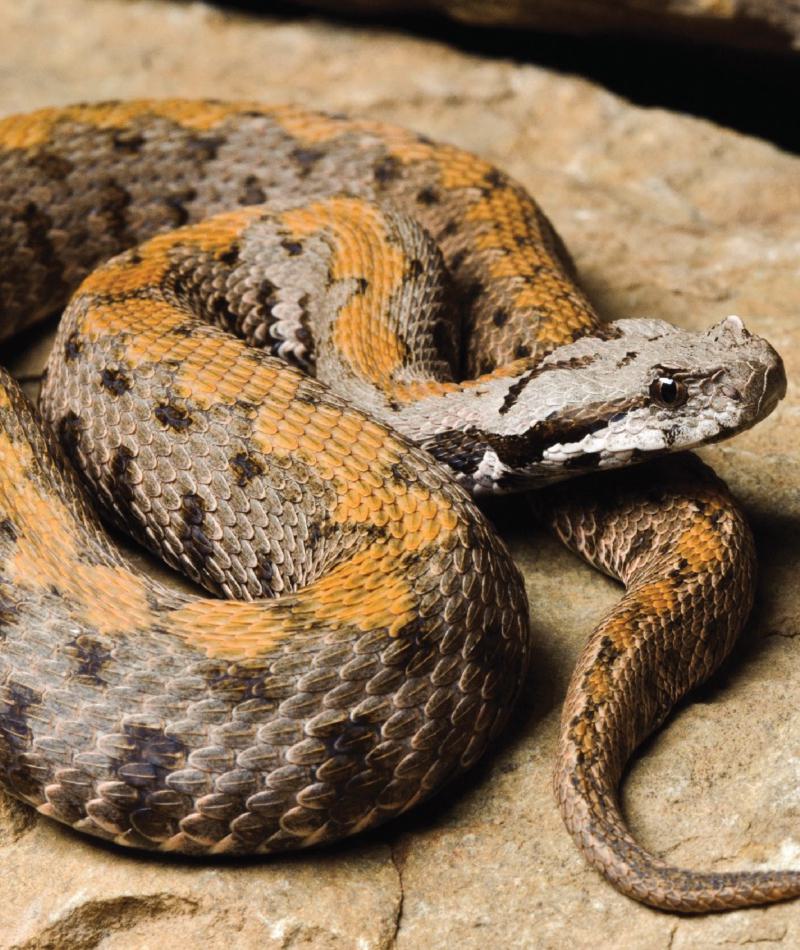
Armenian Viper
Montivipera raddei
Did you know?
- Armenian vipers are part of the family Viperidae, which they share with other vipers.
- They live in rocky habitats in and around Armenia.
- The Saint Louis Zoo is working hard to save Armenian vipers through the Saint Louis Zoo WildCare Institute Center for Conservation in Western Asia.
- May is the month of courtship. A female lies motionless in a secluded, grassy spot. The male "woos" her, crawling along her, flicking his tongue, and moving his head.
- A female gives birth to live young (rather than laying eggs, as many snakes do). The litter can have as few as three babies or as many as 18!
Mountain Viper
The Armenian viper, along with seven other closely related species, belongs to a group called "mountain vipers." Like other mountain viper species, Armenian vipers vary in color. They can be various shades of gray, gray-brown or black. Their backs are covered with round blotches that can be yellow, yellow-orange, brown-orange or red.
Sense of Smell
Like all snakes, the vipers flick their tongues to "sniff" out their next meal. How? Chemical molecules stick to the forks of the tongue. When the snake brings the tongue back into its mouth, the chemical particles are transferred to the Jacobson's organ, located on the roof of the snake's mouth, which helps interpret airborne smells.
Threat Level
- Unknown
- Common
- Near Threatened
- Threatened
- Endangered
- Critically Endangered
- Extinct in the Wild
Near Threatened
The Armenian Viper is likely to qualify for threatened category in the near future, perhaps very quickly depending on local development projects such as mining and habitat destruction.
Range
Armenia and surrounding western Asian countries such as Iran, Turkey, and Iraq
Habitat
Dry, sparsely vegetated rocky slopes at high elevations

We care about Armenian vipers
Armenian vipers are in trouble in the wild. Their numbers have dropped alarmingly. Habitat loss from farming and cattle pasturing accounts for much of the decline. In addition, large numbers of Armenian vipers are collected for their venom, used as a blood-clotting agent in surgery.
The Saint Louis Zoo is working hard to save these animals through the Saint Louis Zoo WildCare Institute Center for Conservation in Western Asia. Over the past decade, the Saint Louis Zoo has become a leader for our captive work with mountain vipers. Learn more about our work supporting the biodiversity of the Caucasus area.
Find this animal in Historic Hill

SAINT LOUIS ZOO ZONE
Historic Hill
Historic Hill is a lovely stroll through one of the oldest parts of the Saint Louis Zoo. From the 1904 World’s Fair Flight Cage to the Spanish architectural flavor of the 1920s in the Bird House, Primate House and Herpetarium to the finishing touches of our thoroughly modern exhibits, this area of the Zoo has a unique ambiance and a nostalgic history that make it a great destination.

